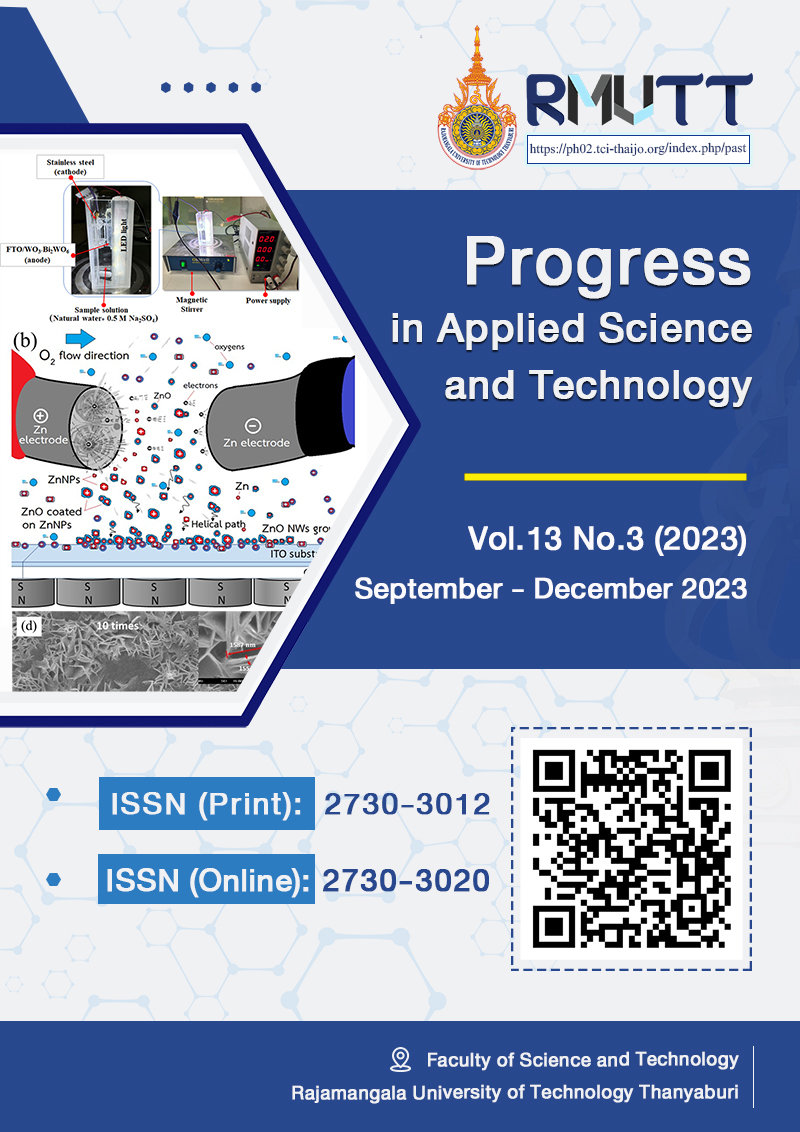Fabrication of a WO3-Bi2WO6 Composite Electrode by Electrodeposition and its Application for Microbial Degradation
Main Article Content
Abstract
Photoelectrocatalytic (PEC) techniques are an innovative and promising method for eliminating microorganisms. Developing and applying such advanced technologies is essential for protecting public health and the environment. Semiconductor electrode development is a major issue in the advancement of such methods. We have developed a technique for fabricating WO3-Bi2WO6 electrodes using cyclic voltammetry (CV), focusing on the efficiency of the reaction and investigating key aspects for its use in microbial degradation. The optimization of the CV method parameter and calcination temperature was conducted in order to enhance the characteristics of composite
WO3-Bi2WO6 electrodes for the aqueous oxidation process. The properties of the fabricated composited WO3-Bi2WO6 electrode were analyzed by several techniques, including UV-visible spectrophotometry, scanning electron microscopy, X-ray diffraction, Energy Dispersive X-ray Spectroscopy, X-ray photoelectron spectroscopy, and electrochemical impedance spectroscopy. The PEC water oxidation and total microorganism elimination efficiencies were investigated to validate the application of the developed composite WO3-Bi2WO6 electrode properties. The characteristics of the prepared composite WO3-Bi2WO6 electrodes are significantly influenced by the calcination temperature. We were able to satisfactorily verify the electrodes' properties in a reaction involving different calcining temperatures. At a calcining temperature of 450 °C, WO3-Bi2WO6 electrodes exhibited excellent PEC activity in water oxidation and electron transfer rate at the electrode surface. The composited WO3-Bi2WO6 electrode can effectively remove 96% of total microorganisms under the PEC process within 15 minutes. This study provides important background information for future work on composite semiconductor thin film preparations with potential applications in microbe eradication and environmental protection.
Article Details

This work is licensed under a Creative Commons Attribution-NonCommercial-NoDerivatives 4.0 International License.
References
Chatchai P, Murakami Y, Kishioka S-y, Nosaka AY, Nosaka Y. Efficient photocatalytic activity of water oxidation over WO3/BiVO4 composite under visible light irradiation. Electrochimica Acta. 2009;54(3):1147-52.
จุฑามาศ ธ, พลเชี่ยว ฉ. Development of photoelectrocatalysis techniques for phenolic compound degradation under solar light. Prog Appl Sci Tech. 2015;5(1):1-8.
Liu Z, Wang Q, Tan X, Zheng S, Zhang H, Wang Y, et al. Solvothermal preparation of Bi/Bi2O3 nanoparticles on TiO2 NTs for the enhanced photoelectrocatalytic degradation of pollutants. J. Alloys Compd. 2020;815:152478.
Zhan S, Zhou F, Huang N, He Q, Zhu Y. Deactivating harmful marine microorganisms through photoelectrocatalysis by GO/ZnWO4 electrodes. Chem Eng J. 2017;330:635-43.
Cho E-C, Hsiao Y-S, Huang J-H, Sung M-Y, Chen Y-L, Wu N-J, et al. Construction of BiVO4/Bi2WO6/WO3 heterojunctions with improved photocatalytic capability in elimination of dye and antibiotics and inactivation of E. coli. J. Taiwan Inst. Chem. Eng. 2023;149:104991.
Song Y, Zhou F, Chai Y, Zhan S. Study on high antibacterial RGO/Bi2WO6 microspheres combined with PEVE coating for marine sterilization under visible light. Research on Chemical Intermediates. 2021;47(6):2297-310.
Huang C, Chen L, Li H, Mu Y, Yang Z. Synthesis and application of Bi2WO6 for the photocatalytic degradation of two typical fluoroquinolones under visible light irradiation. RSC Advances. 2019;9(48):27768-79.
Yang W, Ma B, Wang W, Wen Y, Zeng D, Shan B. Enhanced photosensitized activity of a BiOCl–Bi2WO6 heterojunction by effective interfacial charge transfer. Phys. Chem. Chem. Phys. 2013;15(44).
Zhang J, Liu P, Zhang Y, Xu G, Lu Z, Wang X, et al. Enhanced performance of nano-Bi2WO6-graphene as pseudocapacitor electrodes by charge transfer channel. Sci Rep. 2015;5:8624.
Hwang I-S, Mahadik MA, Song MS, Lee S-W, Oh B-T, Lee HH, et al. Influence of ultrafast microwave deposition on morphology and growth mechanism of WO3 nanosheet photoanode for efficient bacterial inactivation and decomposition of organic pollutants. J. Environ. Chem. Eng. 2023;11(3):109985.
Li J, Liang Z, Guo L, Lei N, Song Q. Flower-like Bi2WO6 with oxygen vacancies achieving enhanced photoelectrocatalytic performance. Materials Letters. 2018;223:93-6.
Jian L, Peng R, He Y, Wang X, Guo W. One-step hydrothermal synthesis of urchin-like WO3 with excellent ammonia gas sensing property. Materials Letters. 2023;336:133897.
Sun C, Wang Y, Su Q. Sol-gel synthesis of Bi2WO6/graphene thin films with enhanced photocatalytic performance for nitric monoxide oxidation under visible light irradiation. Chemical Physics Letters. 2018;702:49-56.
Krüger LU, Cholant CM, Rodrigues MP, Gomez JA, Landarin DM, Lucio CS, et al. Photochromism of doped and undoped WO3 sol-gel films: Determination and analysis of optical constants. Optical Materials. 2022;128:112357.
Zargazi M, Entezari MH. Pulsed sonoelectrodeposition of leaf-like Bi2WO6 film with exposed [001] facet as a photocathode with a remarkable high photovoltage in water splitting. Int. J. Hydrogen Energy. 2023;48(28):10477-92.
Alfaifi BY, Tahir AA, Wijayantha KGU. Fabrication of Bi2WO6 photoelectrodes with enhanced photoelectrochemical and photocatalytic performance. Sol. Energy Mater. Sol. Cells. 2019;195:134-41.
Gao C, Guo X, Nie L, Wu X, Peng L, Chen J. A simple and rapid electrodeposition method to prepare seed layer of WOx on the ITO glass for solvothermal synthesis of WO3 nanowires film. Materials Letters. 2022;328:133136.
Lv Y, Yao W, Zong R, Zhu Y. Fabrication of Wide–Range–Visible Photocatalyst Bi2WO6−x nanoplates via Surface Oxygen Vacancies. Scientific Reports. 2016;6(1):19347.
Zhang M, Lai C, Li B, Huang D, Liu S, Qin L, et al. Ultrathin oxygen-vacancy abundant WO3 decorated monolayer Bi2WO6 nanosheet: A 2D/2D heterojunction for the degradation of Ciprofloxacin under visible and NIR light irradiation. J. Colloid Interface Sci. 2019;556:557-67.
Zhang C, Wu K, Liao H, Debliquy M. Room temperature WO3-Bi2WO6 sensors based on hierarchical microflowers for ppb-level H2S detection. Chem Eng J. 2022;430:132813.
Zhang M, Lai C, Li B, Huang D, Liu S, Qin L, et al. Ultrathin oxygen-vacancy abundant WO3 decorated monolayer Bi2WO6 nanosheet: A 2D/2D heterojunction for the degradation of Ciprofloxacin under visible and NIR light irradiation. J. Colloid Interface Sci. 2019;556:557-67.






